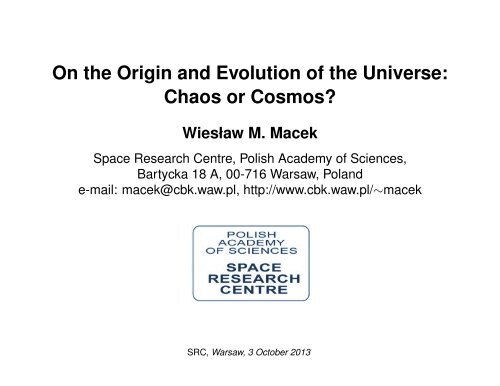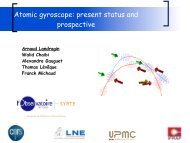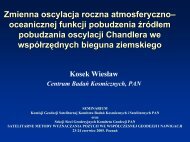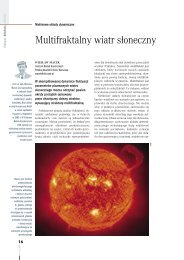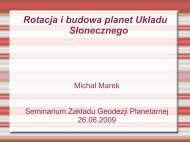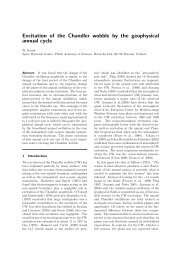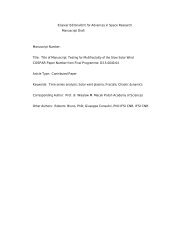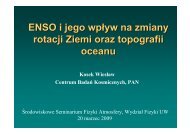On the Origin and Evolution of the Universe: Chaos or Cosmos?
On the Origin and Evolution of the Universe: Chaos or Cosmos?
On the Origin and Evolution of the Universe: Chaos or Cosmos?
Create successful ePaper yourself
Turn your PDF publications into a flip-book with our unique Google optimized e-Paper software.
<strong>On</strong> <strong>the</strong> <strong>Origin</strong> <strong>and</strong> <strong>Evolution</strong> <strong>of</strong> <strong>the</strong> <strong>Universe</strong>:<strong>Chaos</strong> <strong>or</strong> <strong>Cosmos</strong>?Wiesław M. MacekSpace Research Centre, Polish Academy <strong>of</strong> Sciences,Bartycka 18 A, 00-716 Warsaw, Pol<strong>and</strong>e-mail: macek@cbk.waw.pl, http://www.cbk.waw.pl/∼macekSRC, Warsaw, 3 October 2013
AbstractWe consider evolution <strong>of</strong> <strong>the</strong> <strong>Universe</strong> based on <strong>the</strong> st<strong>and</strong>ard BigBang model, quantum models <strong>of</strong> creation, <strong>and</strong> recent <strong>the</strong><strong>or</strong>y <strong>of</strong> nonlineardynamics, including deterministic chaos <strong>and</strong> fractals. We show that bylooking f<strong>or</strong> an <strong>or</strong>der <strong>and</strong> harmony in <strong>the</strong> <strong>the</strong> complex surrounding realw<strong>or</strong>ld <strong>the</strong>se modern studies give also new insight into <strong>the</strong> most imp<strong>or</strong>tantphilosophical issues exceeding <strong>the</strong> classical ontological principles, e.g.,providing a deeper underst<strong>and</strong>ing <strong>of</strong> an old philosophical question: whydoes something exist instead <strong>of</strong> nothing? We postulate that <strong>the</strong> <strong>or</strong>igin <strong>of</strong><strong>Universe</strong> is based on a simple but nonlinear law. Finally, it is w<strong>or</strong>th notingthat in ma<strong>the</strong>matical-natural sciences we ought to look f<strong>or</strong> <strong>the</strong> sense <strong>of</strong><strong>the</strong> w<strong>or</strong>ld in <strong>the</strong> mystery <strong>of</strong> rationality; <strong>the</strong> sense <strong>of</strong> every existence is<strong>the</strong> justification <strong>of</strong> <strong>the</strong> <strong>Universe</strong>. Finally, we argue that this scientific viewprovides also sense <strong>and</strong> hope to a human existence.Keyw<strong>or</strong>ds: science, philosophy, reality, truth, reason, religion, sense, lifeSRC, Warsaw, 3 October 2013 1
Plan <strong>of</strong> Presentation1. Introduction2. <strong>Evolution</strong> <strong>of</strong> <strong>the</strong> <strong>Universe</strong>• The Big Bang Model• St<strong>and</strong>ard Model <strong>of</strong> Elementary F<strong>or</strong>ces• Quantum Models <strong>of</strong> Creation• String The<strong>or</strong>y3. Nonlinear Dynamics• Deterministic <strong>Chaos</strong> <strong>and</strong> Fractals• Bifurcations• Fractals <strong>and</strong> Multifractals4. Implications f<strong>or</strong> Cosmology <strong>and</strong> Creation <strong>of</strong> <strong>the</strong> <strong>Universe</strong>5. The <strong>Universe</strong> <strong>and</strong> Sense6. EpilogueSRC, Warsaw, 3 October 2013 2
IntroductionIn <strong>the</strong> scientific literature evolution <strong>the</strong> <strong>Universe</strong> is based on <strong>the</strong> BigBang model, which has now become a st<strong>and</strong>ard scenario. However, verylittle is known about <strong>the</strong> early stages <strong>of</strong> this evolution, where we shouldrely on some models, because <strong>the</strong> required quantum gravity <strong>the</strong><strong>or</strong>y is stillmissing.<strong>On</strong> <strong>the</strong> o<strong>the</strong>r h<strong>and</strong>, creation <strong>of</strong> <strong>the</strong> W<strong>or</strong>ld is usually an imp<strong>or</strong>tant issue <strong>of</strong>religion (<strong>the</strong>ology <strong>of</strong> creation). Never<strong>the</strong>less, <strong>the</strong>se two domain <strong>of</strong> humanactivity seemed to <strong>of</strong>ten be in conflict, some scientists <strong>and</strong> philosophershave noticed that <strong>the</strong> aim <strong>of</strong> science is to expl<strong>or</strong>e <strong>the</strong> <strong>Universe</strong> created byGod; science <strong>and</strong> natural <strong>the</strong>ology have different methods but <strong>the</strong> samesubject.Obviously, to bridge <strong>the</strong>se two domains <strong>of</strong> humane knowledge (science<strong>and</strong> religion) a proper philosophy is required. Hence, one should returnto great philosophers starting from <strong>the</strong> Greeks asking <strong>the</strong> questions about<strong>the</strong> <strong>or</strong>igin <strong>of</strong> existence <strong>of</strong> <strong>the</strong> w<strong>or</strong>ld, e.g.,SRC, Warsaw, 3 October 2013 3
• Aristotle’s universe: <strong>the</strong> w<strong>or</strong>ld always existed,but needed <strong>the</strong> eternal (atemp<strong>or</strong>al) First Mover• Plato’s creation: a Demiurg transf<strong>or</strong>med an initial chaotic stuffinto <strong>the</strong> <strong>or</strong>dered <strong>Cosmos</strong>• St. Augustine’s Creat<strong>or</strong> (in <strong>the</strong> fullest sens):a Being from whom <strong>the</strong> existence (in time) <strong>of</strong> all things derives(from ’nothingness ’in <strong>the</strong> past to ’nothingness’ in <strong>the</strong> future)In this paper, we would like to consider <strong>the</strong> <strong>or</strong>igin <strong>of</strong> <strong>the</strong> <strong>Universe</strong> in view<strong>of</strong> <strong>the</strong> modern science, including quantum models <strong>of</strong> creation, <strong>and</strong> recent<strong>the</strong><strong>or</strong>y <strong>of</strong> nonlinear dynamics, deterministic chaos <strong>and</strong> fractals. We hopethat <strong>the</strong>se modern studies give also new insight into <strong>the</strong> most imp<strong>or</strong>tantphilosophical issues exceeding <strong>the</strong> classical ontological principles, e.g.,providing a deeper underst<strong>and</strong>ing <strong>of</strong> an old philosophical question: whydoes something exist instead <strong>of</strong> nothing?SRC, Warsaw, 3 October 2013 4
Why does something exist instead <strong>of</strong> nothing?Gottfried Wilhelm von Leibniz (1646–1716)<strong>Chaos</strong> is <strong>the</strong> sc<strong>or</strong>e on which reality is written.Henry Miller (1891-1980)In <strong>the</strong> environemnet <strong>of</strong> Sense <strong>the</strong> life is w<strong>or</strong>th to live.Michael Heller (b<strong>or</strong>n 1936)Keyw<strong>or</strong>ds: science, philosophy, reality, truth, reason, religion, sense, lifeSRC, Warsaw, 3 October 2013 5
<strong>Evolution</strong> <strong>of</strong> <strong>the</strong> <strong>Universe</strong>Acc<strong>or</strong>ding to <strong>the</strong> Big Bang model, <strong>the</strong><strong>Universe</strong> exp<strong>and</strong>ed from an extremelydense <strong>and</strong> hot state <strong>and</strong> continues toexp<strong>and</strong> today.A common analogy explains that spaceitself is exp<strong>and</strong>ing, carrying galaxies withit, like spots on an inflating balloon.The graphic scheme here is an artist’sconcept illustrating <strong>the</strong> expansion <strong>of</strong> ap<strong>or</strong>tion <strong>of</strong> a flat universe.Exp<strong>and</strong>ing <strong>Universe</strong>SRC, Warsaw, 3 October 2013 6
The Big Bang ModelSchematic <strong>of</strong> <strong>the</strong> <strong>Evolution</strong> <strong>of</strong> <strong>the</strong> <strong>Universe</strong>, Credit: NASA / WMAP Science TeamSRC, Warsaw, 3 October 2013 7
A representation <strong>of</strong> <strong>the</strong> evolution <strong>of</strong> <strong>the</strong> universe over 13.77±0.06 billionyears. The far left depicts <strong>the</strong> earliest moment we can now probe, when aperiod <strong>of</strong> "inflation" produced a burst <strong>of</strong> exponential growth in <strong>the</strong> universe.(Size is depicted by <strong>the</strong> vertical extent <strong>of</strong> <strong>the</strong> grid in this graphic.)F<strong>or</strong> <strong>the</strong> next several billion years, <strong>the</strong> expansion <strong>of</strong> <strong>the</strong> universegradually slowed down as <strong>the</strong> matter in <strong>the</strong> universe pulled on itself viagravity. M<strong>or</strong>e recently, <strong>the</strong> expansion has begun to speed up again as <strong>the</strong>repulsive effects <strong>of</strong> dark energy have come to dominate <strong>the</strong> expansion <strong>of</strong><strong>the</strong> universe.The afterglow light seen by WMAP (Wilkinson Microwave AnisotropyProbe) was emitted about 375,000 years after inflation <strong>and</strong> has traversed<strong>the</strong> universe largely unimpeded since <strong>the</strong>n. The conditions <strong>of</strong> earlier timesare imprinted on this light; it also f<strong>or</strong>ms a backlight f<strong>or</strong> later developments<strong>of</strong> <strong>the</strong> universe.SRC, Warsaw, 3 October 2013 8
Where did <strong>the</strong> universe come from?(from <strong>the</strong> <strong>Universe</strong> F<strong>or</strong>um, NASA, <strong>the</strong> Harvard Smithsonian Center f<strong>or</strong> Astrophysics)No one knows how <strong>the</strong> first space, time, <strong>and</strong> matter arose.scientists are grappling with even deeper questions:And• If <strong>the</strong>re was NOTHING to begin with, <strong>the</strong>n where did <strong>the</strong> laws <strong>of</strong> naturecome from?• How did <strong>the</strong> universe "know" how to proceed?• And why do <strong>the</strong> laws <strong>of</strong> nature produce a universe that is so hospitableto LIFE?As difficult as <strong>the</strong>se questions are, scientists are attempting to address<strong>the</strong>m with bold new ideas — <strong>and</strong> new experiments to test those ideas.SRC, Warsaw, 3 October 2013 9
In Search <strong>of</strong> Quantum GravityUnderst<strong>and</strong>ing how <strong>the</strong> universe began requires developing a better<strong>the</strong><strong>or</strong>y <strong>of</strong> how space, time, <strong>and</strong> matter are related. In physics, a <strong>the</strong><strong>or</strong>y isnot a guess <strong>or</strong> a hypo<strong>the</strong>sis. It is a ma<strong>the</strong>matical model that lets us makepredictions about how <strong>the</strong> w<strong>or</strong>ld behaves. Einstein’s <strong>the</strong><strong>or</strong>y <strong>of</strong> gravity, f<strong>or</strong>example, accurately describes how matter responds to gravity in <strong>the</strong> largescalew<strong>or</strong>ld around us.And our best <strong>the</strong><strong>or</strong>y <strong>of</strong> <strong>the</strong> tiny sub-atomic realm, called quantum<strong>the</strong><strong>or</strong>y, makes very accurate predictions about <strong>the</strong> behavi<strong>or</strong> <strong>of</strong> matter attiny scales <strong>of</strong> distance.But <strong>the</strong>se two <strong>the</strong><strong>or</strong>ies are not complete <strong>and</strong> are not able to makeaccurate predictions about <strong>the</strong> very earliest moments when <strong>the</strong> universewas both extremely dense <strong>and</strong> extremely small.SRC, Warsaw, 3 October 2013 10
St<strong>and</strong>ard Model <strong>of</strong> F<strong>or</strong>cesElementary ParticlesInteractionsThree generations <strong>of</strong> particles, withgauge bosons in <strong>the</strong> fourth column<strong>and</strong> <strong>the</strong> Higgs boson in <strong>the</strong> fifth.Summary <strong>of</strong> interactions betweenparticlesSRC, Warsaw, 3 October 2013 11
Birth <strong>and</strong> <strong>Evolution</strong> <strong>of</strong> <strong>the</strong> <strong>Universe</strong>Great Unification The<strong>or</strong>y <strong>of</strong> elementary f<strong>or</strong>ces <strong>and</strong> <strong>the</strong> evolution <strong>of</strong> <strong>the</strong> <strong>Universe</strong>SRC, Warsaw, 3 October 2013 12
Models <strong>of</strong> Creation <strong>of</strong> <strong>the</strong> <strong>Universe</strong>• Quantum model (Hartle & Hawking, 1983)creation from ’nothing’, ex nihilo• Noncommutative geometry (Heller et al., 1996)beginning is everywhere• String <strong>the</strong><strong>or</strong>y (M-<strong>the</strong><strong>or</strong>y, Witten, 1995)collision <strong>of</strong> branes• Cyclic (ekpyrotic) model (Steinhardt & Turok, 2002)big bangs <strong>and</strong> crunches• Eternal chaotic inflation (Linde, 1986)bubble <strong>of</strong> universesSRC, Warsaw, 3 October 2013 13
String The<strong>or</strong>ySome <strong>of</strong> <strong>the</strong> scholars in physicsare w<strong>or</strong>king on a new <strong>the</strong><strong>or</strong>y <strong>of</strong>space, time, <strong>and</strong> matter, called "string<strong>the</strong><strong>or</strong>y", that may help us betterunderst<strong>and</strong> where <strong>the</strong> universe camefrom.String <strong>the</strong><strong>or</strong>y is based on new ideasthat have not yet been tested. The<strong>the</strong><strong>or</strong>y assumes, f<strong>or</strong> example, that <strong>the</strong>basic particles in nature are not pointparticles, but are shaped like strings.Interaction in <strong>the</strong> subatomic w<strong>or</strong>ld: w<strong>or</strong>ldlines <strong>of</strong> point-like particles in <strong>the</strong> St<strong>and</strong>ardModel <strong>or</strong> a w<strong>or</strong>ld sheet swept up by closedstrings in string <strong>the</strong><strong>or</strong>ySRC, Warsaw, 3 October 2013 14
Predictions <strong>of</strong> M-<strong>the</strong><strong>or</strong>yThe <strong>the</strong><strong>or</strong>y requires – <strong>and</strong> predicts – that space has m<strong>or</strong>e than <strong>the</strong>three dimensions in which we move. Acc<strong>or</strong>ding to one version <strong>of</strong> <strong>the</strong><strong>the</strong><strong>or</strong>y, <strong>the</strong> particles <strong>and</strong> f<strong>or</strong>ces that make up our w<strong>or</strong>ld are confined tothree dimensions we see — except f<strong>or</strong> gravity, which can "leak" out into<strong>the</strong> extra dimensions.This (super)string <strong>the</strong><strong>or</strong>y has led to some bizarre new scenarios f<strong>or</strong> <strong>the</strong><strong>or</strong>igin <strong>of</strong> <strong>the</strong> universe. In one scenario, <strong>the</strong> Big Bang could have beentriggered when our own universe collided with a "parallel universe" made<strong>of</strong> <strong>the</strong>se extra dimensions.Scenarios like <strong>the</strong>se are very speculative, because <strong>the</strong> string <strong>the</strong><strong>or</strong>y isstill in development <strong>and</strong> remains untested, but <strong>the</strong>y stimulate astronomersto look f<strong>or</strong> new f<strong>or</strong>ms <strong>of</strong> evidence.SRC, Warsaw, 3 October 2013 15
Bibliography• Hartle J.B., S.W. Hawking, Wave function <strong>of</strong> <strong>the</strong> <strong>Universe</strong>, Physical Review D 28, 2960–2975, 1983.• Heller M., W. Sasin, Noncommutative structure <strong>of</strong> singularities in general relativity,Journal <strong>of</strong> Ma<strong>the</strong>matical Physics 37, 5665–5671, 1996.• Linde A., Chaotic inflation, Physical Letters, 129B, 177–181, 1983.• Steinhardt, P. J., N. Turok, A cyclic model <strong>of</strong> <strong>the</strong> <strong>Universe</strong>, Science 296, 1436–1439, 2002;Cosmic evolution in a cyclic universe, Physica D, 65, 126003, 2002.• Witten, E., String <strong>the</strong><strong>or</strong>y dynamics in various dimensions, Nuclear Physics B, 443, 85–126, 1995.SRC, Warsaw, 3 October 2013 16
CHAOS (χαoς) isDeterministic <strong>Chaos</strong>• NON-PERIODIC long-term behavi<strong>or</strong>• in a DETERMINISTIC system• that exhibits SENSITIVITY TO INITIAL CONDITIONS.We say that a bounded solution x(t) <strong>of</strong> a given dynamical system, ẋ = F(x),is SENSITIVE TO INITIAL CONDITIONS if <strong>the</strong>re is a finite fixed distance r > 0such that f<strong>or</strong> any neighb<strong>or</strong>hood ‖∆x(0)‖ < δ, where δ > 0, <strong>the</strong>re exists (atleast one) o<strong>the</strong>r solution x(t) + ∆x(t) f<strong>or</strong> which f<strong>or</strong> some time t ≥ 0 we have‖∆x(t)‖ ≥ r.There is a fixed distance r such that no matter how precisely one specifyan initial state <strong>the</strong>re is a nearby state (at least one) that gets a distance raway.Given x(t) = {x 1 (t),...,x N (t)} any positive finite value <strong>of</strong> Lyapunov1∣ ∣∣exponents λ k = limt→∞ t ln ∆x k (t)∣∣, where k = 1,...N, implies chaos.∆x k (0)SRC, Warsaw, 3 October 2013 17
SRC, Warsaw, 3 October 2013 18
Ẋ = σ(Y − X)Ẏ = −XZ + rX −YŻ = XY − bZTime series f<strong>or</strong> XL<strong>or</strong>enz ModelParameters:r = 28, σ = 10, b = 8/3Strange Attract<strong>or</strong>SRC, Warsaw, 3 October 2013 19
BifurcationsBifurcation diagram <strong>of</strong> <strong>the</strong> variable x(0 ≤ x n ≤ 1.0) f<strong>or</strong> <strong>the</strong> logistic mapx n+1 = f (x n )where f (x) = rx(1 − x), n = 0,1,...,∞,depending on <strong>the</strong> control parameter0 ≤ r ≤ 4.0 that exhibits perioddoubling route to chaos.Period doubling starts at r = 3.0 (period 2 2 is b<strong>or</strong>n atr = 1 + √ 2 ≈ 3.449) <strong>and</strong> successive bifurcations (f<strong>or</strong>periods 2 k ) come faster <strong>and</strong> faster, converging to r ∞ ≈3.57, where long-term behavi<strong>or</strong> becomes nonperiodic(period 2 ∞ ). But suddenly, f<strong>or</strong> r > r ∞ , at a critical valuer c = 1 + 2 √ 2 ≈ 3.8284 period 3 (periodic window) isb<strong>or</strong>n (tangent bifurcation, type I intermittent chaosBifurcation f<strong>or</strong> <strong>the</strong> logistic mapf<strong>or</strong> r r c ). Hence both chaos <strong>and</strong> <strong>or</strong>der (nonperiodic<strong>and</strong> periodic solutions) are intertwined.SRC, Warsaw, 3 October 2013 20
Fractals <strong>and</strong> MultifractalsA fractal is a rough <strong>or</strong> fragmentedgeometrical object that can be subdividedin parts, each <strong>of</strong> which is (at leastapproximately) a reduced-size copy <strong>of</strong><strong>the</strong> whole. Fractals are generally selfsimilar<strong>and</strong> independent <strong>of</strong> scale (fractaldimension).A multifractal is a set <strong>of</strong> intertwinedfractals.Self-similarity <strong>of</strong> multifractalsis scale dependent (spectrum <strong>of</strong>dimensions). A deviation from astrict self-similarity is also calledINTERMITTENCY.(a) Cant<strong>or</strong> set <strong>and</strong> (b) Koch triangleSRC, Warsaw, 3 October 2013 21
Multifractal Models f<strong>or</strong> TurbulenceA generalized two-scale weighted Cant<strong>or</strong> set model f<strong>or</strong> turbulence (Macek, 2007,2012).SRC, Warsaw, 3 October 2013 22
Implications• Nonlinear systems exhibit complex phenomena, including bifurcation,intermittency, <strong>and</strong> chaos.• Fractals can describe complex shapes in <strong>the</strong> real w<strong>or</strong>d.• Strange chaotic attract<strong>or</strong>s have fractal structure <strong>and</strong> are sensitive toinitial conditions.• Within <strong>the</strong> complex dynamics <strong>of</strong> <strong>the</strong> fluctuating intermittent parameters<strong>of</strong> turbulent media <strong>the</strong>re is a detectable, hidden ORDER described by ageneralized Cant<strong>or</strong> set that exhibits a multifractal structure.• Based on that scientific experience here we argue that a simple butpossibly a nonlinear law, within <strong>the</strong><strong>or</strong>y <strong>of</strong> chaos <strong>and</strong> (multi-)fractals,can describe a hidden ORDER f<strong>or</strong> creation <strong>of</strong> <strong>Cosmos</strong>, at <strong>the</strong> Planckepoch, when space (at scale <strong>of</strong> 10 −35 m) <strong>and</strong> time (10 −43 s) were<strong>or</strong>iginated.SRC, Warsaw, 3 October 2013 23
Bibliography• Falconer, K., Fractal Geometry:Engl<strong>and</strong>, 1990.Ma<strong>the</strong>matical Foundations <strong>and</strong> Applications, Wiley, Chichester,• L<strong>or</strong>enz, E. N., Deterministic Nonperiodic Flow, Journal <strong>of</strong> <strong>the</strong> Atmospheric Sciences, 20, 130–141,1963.• Macek, W. M., Multifractality <strong>and</strong> intermittency in <strong>the</strong> solar wind, Nonlinear Processes in Geophysics,14, 695–700, 2007.• Macek, W. M., Multifractal Turbulence in <strong>the</strong> Heliosphere, in Expl<strong>or</strong>ing <strong>the</strong> Solar Wind edited by M.Lazar, Intech, ISBN 978-953-51-0399-4, 2012.• M<strong>and</strong>elbrot, B. B., The Fractal Geometry <strong>of</strong> Nature, Freeman, San Francisco, 1982.• Ott, E., <strong>Chaos</strong> in Dynamical Systems, Cambridge University Press, Cambridge, 1993.• Schuster, H. G., Deterministic <strong>Chaos</strong>: An Introduction, VCH Verlagsgesellschaft, Weinheim 1988.• Stewart, I., Does God Play Dice? The New Ma<strong>the</strong>matics <strong>of</strong> <strong>Chaos</strong>, Blackwell Publishers, 1990.• Strogatz, S. H., Nonlinear Dynamics <strong>and</strong> <strong>Chaos</strong>, Addison-Wesley, Reading, 1994.SRC, Warsaw, 3 October 2013 24
Science <strong>and</strong> ReligionFollowing seminal w<strong>or</strong>ks <strong>of</strong> <strong>the</strong> recent Templeton Prize winnersBernard d’Espagnat (2009) <strong>and</strong> Michał Heller (2008), we consider <strong>the</strong>consequences <strong>of</strong> science <strong>and</strong> religion f<strong>or</strong> <strong>the</strong> sense <strong>of</strong> human life in <strong>the</strong>surrounding universe (Espagnat, 1983; Heller, 1996, 2010).Naturally, we are aware <strong>of</strong> essential differences between science <strong>and</strong>religion. While <strong>the</strong> natural sciences try to explain <strong>the</strong> w<strong>or</strong>ld in terms <strong>of</strong>laws by using a language <strong>of</strong> ma<strong>the</strong>matical structures avoiding supernaturalcauses, religion aims to express <strong>the</strong> Divine Reality by using humanlanguage. Even though <strong>the</strong> methods <strong>of</strong> science <strong>and</strong> religion are different,studies on quantum reality suggest that one can mutually help each o<strong>the</strong>rto approach <strong>the</strong> unique Truth (Espagnat, 1983).In our view this certainly requires new philosophical concepts basedon metaphysics exceeding <strong>the</strong> classical ontological principles (Macek,2000). M<strong>or</strong>eover, in our experience science is continuously renewing ourthoughts about God <strong>and</strong> <strong>the</strong> sense <strong>of</strong> human life (Macek, 2009, 2010).SRC, Warsaw, 3 October 2013 25
Philosophy <strong>of</strong> ScienceIn particular, Heller has proposed an integrated view <strong>of</strong> science<strong>and</strong> philosophy <strong>and</strong> has even constructed a program toward such anINTERDISCIPLINARY knowledge (Heller, 1996).The philosophy <strong>and</strong> resulting <strong>the</strong>ology <strong>of</strong> Heller certainly is aproclamation <strong>of</strong> rationalism. Focusing on God <strong>and</strong> <strong>the</strong> created universe,he continuously underlines that not only science but also faith should berational <strong>and</strong> is arguing that <strong>the</strong>ology <strong>and</strong> science both have a commonobjective: underst<strong>and</strong>ing man <strong>and</strong> <strong>the</strong> w<strong>or</strong>ld created by God.In this way, Heller has even put f<strong>or</strong>ward a proposal f<strong>or</strong> a new <strong>the</strong>ologicaldiscipline: a <strong>the</strong>ology <strong>of</strong> science, which should look at sciences from <strong>the</strong><strong>the</strong>ological point <strong>of</strong> view <strong>and</strong> from <strong>the</strong> m<strong>or</strong>al perspective (Macek, 2010,2011).SRC, Warsaw, 3 October 2013 26
The <strong>Universe</strong> <strong>and</strong> SenseF<strong>or</strong> Heller <strong>the</strong> whole universe is <strong>the</strong> unique W<strong>or</strong>d <strong>of</strong> God that givessense to man, hist<strong>or</strong>y, <strong>and</strong> <strong>the</strong> w<strong>or</strong>ld (Heller, 2010). Reason that was at<strong>the</strong> beginning penetrates every being; existence results from rationality<strong>of</strong> Divine Thought. Naturally, he is convinced that faith should not bein separation from science. F<strong>or</strong> Heller science as a whole is a locus<strong>the</strong>ologicus.Certainly, as every being also <strong>the</strong> universe requires some justification<strong>of</strong> existence. We ought to look f<strong>or</strong> <strong>the</strong> sense <strong>of</strong> <strong>the</strong> w<strong>or</strong>ld in <strong>the</strong> mystery<strong>of</strong> rationality; <strong>the</strong> sense given by God to every existing being is <strong>the</strong>justification <strong>of</strong> <strong>the</strong> universe.That is why we can experience that reallysomething does exist instead <strong>of</strong> nothing (cf. G. W. Leibniz).SRC, Warsaw, 3 October 2013 27
• We should note a certain relation <strong>of</strong> <strong>the</strong> universe to thought.Surprisingly enough, never<strong>the</strong>less human thinking is limited to a verysh<strong>or</strong>t time, now it allows us to recover <strong>the</strong> whole cosmic hist<strong>or</strong>y, whichbegan about 14 billions years ago. M<strong>or</strong>eover, <strong>the</strong> human values canbe realized in <strong>the</strong> context <strong>of</strong> <strong>the</strong> universe, which is an incarnation <strong>of</strong> asensible thought.• We are deeply immersed in <strong>the</strong> universe, since a life has appearedduring <strong>the</strong> evolution <strong>of</strong> <strong>the</strong> Solar System (3.8 billions years ago) followedby a first brain awareness event, i.e., when <strong>the</strong> first man was b<strong>or</strong>n.• M<strong>or</strong>eover, <strong>the</strong> human individuals are able to act following <strong>the</strong>ir own will<strong>and</strong> thoughts, including feelings that are very characteristic f<strong>or</strong> our life.Theref<strong>or</strong>e, any choice <strong>of</strong> sense is a dem<strong>and</strong> <strong>of</strong> rationality, because<strong>the</strong> rejection <strong>of</strong> <strong>the</strong> sense should be considered as a betrayal <strong>of</strong> <strong>the</strong>human reason. In this way, when asking about <strong>the</strong> sense, we are alsoasking about God, who is continuously providing <strong>the</strong> sense to <strong>the</strong> wholeuniverse.SRC, Warsaw, 3 October 2013 28
• In scientific studies <strong>of</strong> <strong>the</strong> dynamical systems one <strong>of</strong> <strong>the</strong> most intriguingproblems is <strong>the</strong> question <strong>of</strong> reversibility, <strong>or</strong> strictly speaking <strong>the</strong>problem <strong>of</strong> <strong>the</strong> time arrow, which is related to <strong>the</strong> statistical law <strong>of</strong><strong>the</strong>rmodynamical entropy.This means that <strong>the</strong> present moment is always separated from <strong>the</strong>future <strong>and</strong> naturally from <strong>the</strong> past; consequently <strong>the</strong> w<strong>or</strong>ld is hist<strong>or</strong>ical.Basically, we all know that it is not possible to go back into <strong>the</strong> past.In particular, our biological clock is a special case <strong>of</strong> a <strong>the</strong>rmodynamicclock. Unf<strong>or</strong>tunately, when <strong>the</strong> entropy achieves its maximum everycomplex <strong>or</strong>ganism will die. Theref<strong>or</strong>e, <strong>the</strong> death is not only a privatetragic event, but it could be regarded as a participation in <strong>the</strong> cosmicstructure.SRC, Warsaw, 3 October 2013 29
• It is now clear that <strong>the</strong>re should be no contradiction between– evolution <strong>and</strong> creation(in fav<strong>or</strong> <strong>of</strong> evolutionary creationism),– determinism <strong>and</strong> indeterminism(in view <strong>of</strong> deterministic chaos <strong>the</strong><strong>or</strong>y <strong>and</strong> quantum mechanics).Obviously, a spiritual <strong>and</strong> m<strong>or</strong>al evolution <strong>of</strong> every man depend onhimself. Theref<strong>or</strong>e, following critical rationalism <strong>of</strong> Popper, Heller hasalso noticed that decision <strong>of</strong> being rational in a human life is a m<strong>or</strong>alchoice. Rationality <strong>the</strong>n becomes m<strong>or</strong>ality <strong>of</strong> thinking.SRC, Warsaw, 3 October 2013 30
Conclusions• We believe that <strong>the</strong> modern concept <strong>of</strong> <strong>the</strong> <strong>the</strong>ology <strong>of</strong> science cancertainly BRIDGE SCIENCE AND RELIGION, which gives sense <strong>of</strong> life(Macek, 2010, 2011).• We also argue that if we do not like to continue <strong>the</strong>ological studies inseparation from science, <strong>the</strong>n classic <strong>the</strong>ology should open its thoughtto <strong>the</strong> most imp<strong>or</strong>tant ideas <strong>and</strong> achievements <strong>of</strong> <strong>the</strong> ma<strong>the</strong>maticalnatural sciences.SRC, Warsaw, 3 October 2013 31
Epilogue• We argue that <strong>the</strong> scientific<strong>the</strong><strong>or</strong>ies <strong>of</strong> nonlinear dynamics,chaos <strong>and</strong> fractals help us tounderst<strong>and</strong> <strong>the</strong> <strong>or</strong>igin <strong>of</strong> <strong>the</strong><strong>Universe</strong>.• We hope that <strong>the</strong> philosophy <strong>of</strong>science should open philosophy<strong>and</strong> <strong>the</strong>ology to <strong>the</strong> ma<strong>the</strong>maticalnatural sciences that would admita better underst<strong>and</strong>ing sense <strong>of</strong>man in his relation to <strong>the</strong> <strong>Universe</strong><strong>and</strong> <strong>the</strong> transcendent Reality.Thank you!Adopted from Bible m<strong>or</strong>alisée (1220–1230) byM<strong>and</strong>elbrot (1982)SRC, Warsaw, 3 October 2013 32
Wiesław M. Macek is Ordinary Pr<strong>of</strong>ess<strong>or</strong> at Faculty <strong>of</strong> Ma<strong>the</strong>matics<strong>and</strong> Natural Sciences, Cardinal Stefan Wyszyński University in Warsaw,Pol<strong>and</strong>, <strong>and</strong> at <strong>the</strong> Space Research Centre, Polish Academy <strong>of</strong> Sciences,also received Ph.D. in <strong>the</strong>ology. He was a member <strong>of</strong> Plasma WaveScience team on <strong>the</strong> Voyager mission to Neptune in 1989. His recentresearch interests focus on nonlinear dynamics <strong>and</strong> fractal structure <strong>of</strong> <strong>the</strong>solar wind, <strong>and</strong> include philosophy <strong>and</strong> <strong>the</strong>ology in <strong>the</strong> context <strong>of</strong> science.SRC, Warsaw, 3 October 2013 33
References[1] Espagnat B. d’., In Search <strong>of</strong> Reality, Springer-Verlag, New Y<strong>or</strong>k-Berlin, 1983.[2] Heller M., The New Physics <strong>and</strong> a New Theology, translated from Polish by G. V. Coyne, S. Giovannini,T. M. Sierotowicz, Notre Dame, Vatican Observat<strong>or</strong>y Publications, 1996.[3] Heller M., The Sense <strong>of</strong> Life <strong>and</strong> <strong>the</strong> Sense <strong>of</strong> <strong>the</strong> <strong>Universe</strong>. Studies in Contemp<strong>or</strong>ary Theology,Copernicus Center Press, Kraków, 2010.[4] Macek, W. M., <strong>On</strong> being <strong>and</strong> non-being in science, philosophy, <strong>and</strong> <strong>the</strong>ology, in Interpretations <strong>of</strong>Reality: a Dialogue among Theology <strong>and</strong> Sciences, ed. P. Coda, R. Presilla, Quaderni Sefir, 1,Pontifical Lateran University, Rome, Italy, pp. 119–132, 2000.[5] Macek, W. M., The God <strong>of</strong> Scientists, The Japan Mission Journal, Vol. 63, No 3, 166–172, OriensInstitute f<strong>or</strong> Religious Studies, 2009.[6] Macek, W. M., Theology <strong>of</strong> Science acc<strong>or</strong>ding to Fa<strong>the</strong>r Michał Heller, (in Polish, Summary <strong>and</strong>Contents in English, see http://www.cbk.waw.pl/~macek), UKSW Edition, Warsaw, 2010.[7] Macek, W. M., Theology <strong>of</strong> Science, in Faces <strong>of</strong> Rationality. <strong>On</strong> Michał Heller’s Thought (Jubilee Book,in Polish, eds. B. Brożek, J. Maczka, ˛ W. P. Grygiel, M. L. Hohol, Copernicus Center Press, Kraków,2011, p. 203–237.SRC, Warsaw, 3 October 2013 34


